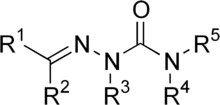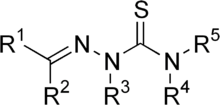Semicarbazone



In organic chemistry, a semicarbazone is a derivative of imines formed by a condensation reaction between a ketone or aldehyde and semicarbazide. They are classified as imine derivatives because they are formed from the reaction of an aldehyde or ketone with the terminal -NH2 group of semicarbazide, which behaves very similarly to primary amines.
Formation
- For ketones
- H2NNHC(=O)NH2 + RC(=O)R → R2C=NNHC(=O)NH2
- For aldehydes
- H2NNHC(=O)NH2 + RCHO → RCH=NNHC(=O)NH2
For example, the semicarbazone of acetone would have the structure (CH3)2C=NNHC(=O)NH2.
Properties and uses
Some semicarbazones, such as nitrofurazone, and thiosemicarbazones are known to have anti-viral and anti-cancer activity, usually mediated through binding to copper or iron in cells. Many semicarbazones are crystalline solids, useful for the identification of the parent aldehydes/ketones by melting point analysis.[1]
Thiosemicarbazone
A thiosemicarbazone is an analog of a semicarbazone which contains a sulfur atom in place of the oxygen atom.